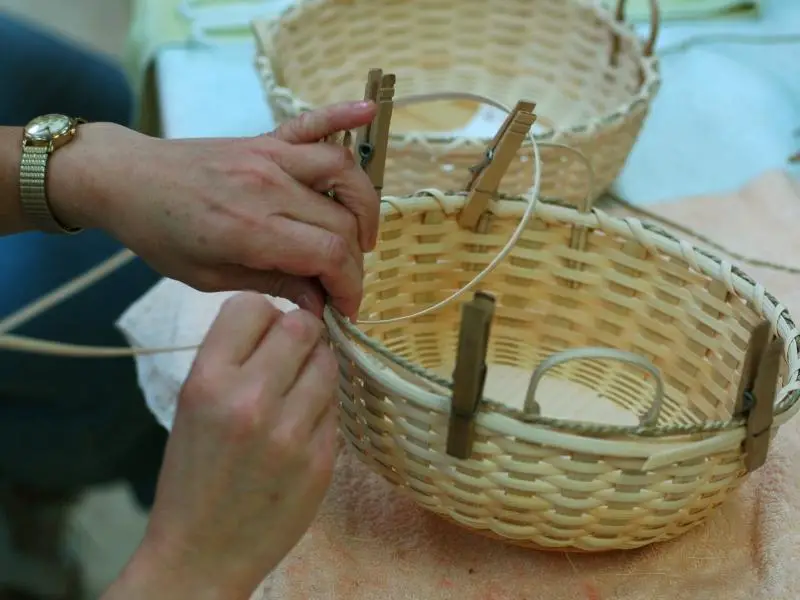Basket weaving is an ancient craft that people have been doing for thousands of years. While explorers discovered the earliest known baskets in 27,000 BC, it’s commonly believed that basket weaving dates to older than this. However, baskets are made from natural materials that rot, so detecting them after such a long time is closer to being impossible.
And while many materials and techniques disappeared underneath the ruins of time, the craft itself remains standing proudly.
If you want to take up basket weaving as a hobby, you should know how it’s done. So what are the three techniques used in basket weaving? We’ll tell you all about them, so bear with us!
Basket Weaving: Three Different Techniques
Here are our detailed explanations of the three main weaving techniques that you can try out.
1. Coiling
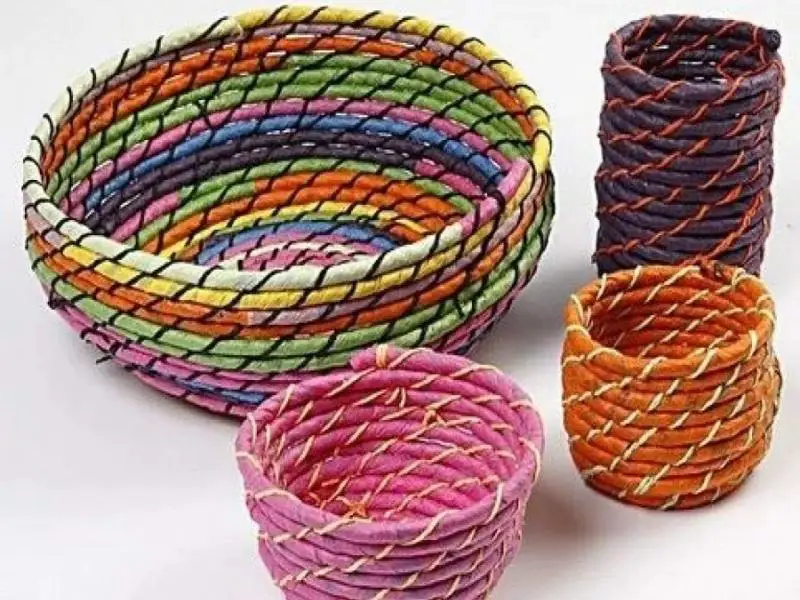
Coiling is one of the most common basket weaving techniques. It consists of wrapping a core material, usually referred to as spoke, with the fibrous or pliable materials you’re working with, often known as weavers.
After that, you should sew your materials together with thread or fiber in a spiraling fashion. Coiled baskets often look circular or round because of the spiral pattern, unlike most baskets that look square or rectangular.
People used materials like pine needles, willow, sweetgrass, straw, or grasses to make such baskets throughout history. And for the sewing part, they used horsehair or raffia.
They used the coiled baskets to store food and water, but nowadays, they have more of a decorative role because of their intricate weaving and elegant looks.
While coiling isn’t the most challenging basket weaving technique, it takes focus and practice to ace. However, to avoid overwhelming yourself, you can start with a small, round basket and go from there.
2. Wicker
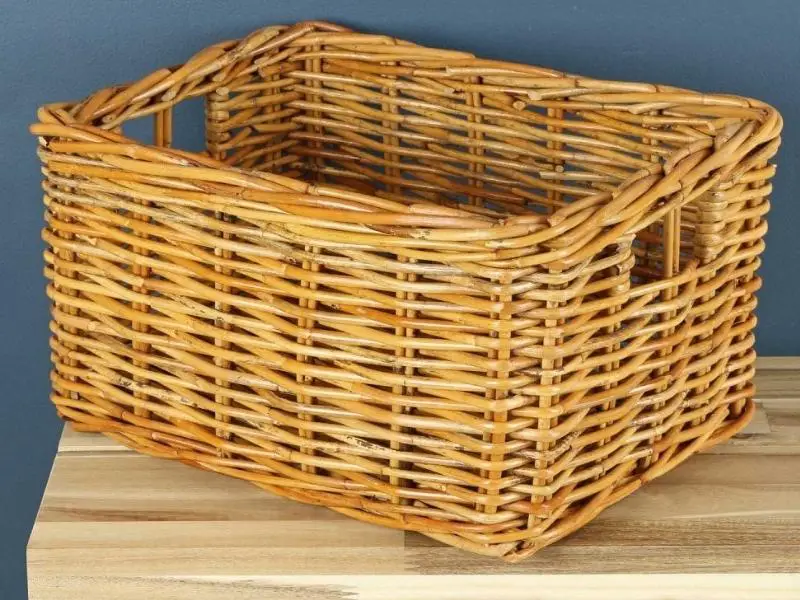
Wicker baskets aren’t for the faint of heart; they’re the most challenging to make. But if you start basket weaving, you might as well give them a try.
Wicker is one of the most ancient basket weaving techniques, and the oldest wicker furniture piece known to man has been found in ancient Egypt. It’s almost similar to another basketry technique called twinning.
Wicker, also commonly known as splint basketry, consists of weaving the basket material around spokes in an alternating fashion between underneath and above.
In other words, you’ll pass your material through the spokes, once under the spoke and once over it. While some wicker baskets have only one spoke, some have multiple ones that you can wrap the material around.
The main difference between wicker basket making and twinning is that in the former, you don’t need to cross the weaving materials over each other in between the spokes.
You can use plant materials like grass, reed, or willow to make such baskets, with willow being the most common material. The reason it’s more common is that it results in sturdy and durable baskets that look beautiful.
Ideally, it’ll be best to use thin willow rods for the weavers and rigid willow rods for the spokes. Some people also use cedar bark since it’s flexible.
Although most basket makers agree that wicker baskets are exceedingly challenging to make, the results are often stunning. So, if you have some time on your hands, you can try making a wicker basket.
3. Plaiting
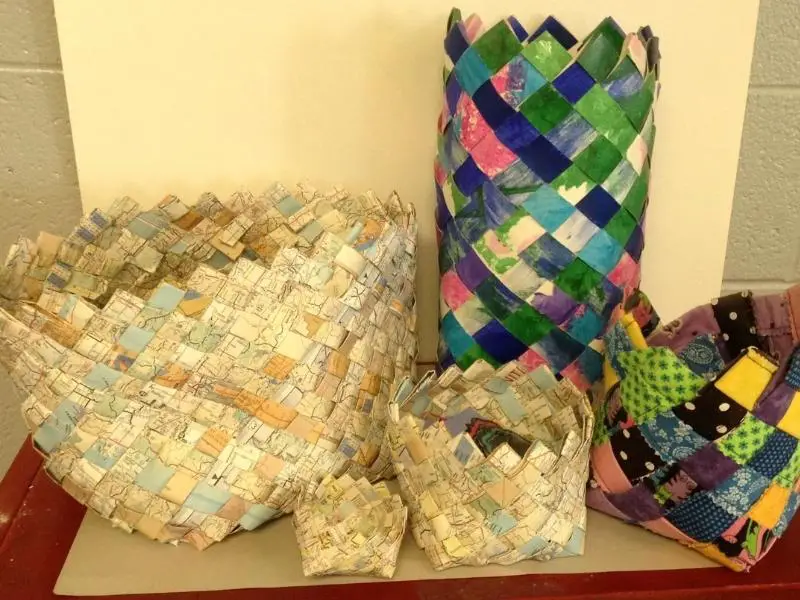
Among basket weaving techniques, plaiting is both the most common and the easiest technique. It’s an ideal choice if you’re a beginner, and you should start with it if you’ve recently started making baskets.
The plaiting weaving process consists of passing thick strips of basket materials under and over each other, making for an elegant pattern that resembles a checkerboard pattern. Unlike other basket weaving techniques that result in round baskets, the plaiting technique breeds rectangular or square ones.
The most common materials used to create baskets using plaiting are tropical plant leaves like palm or yucca because of their thick and durable nature.
You might come across two basic techniques: simple and pattern plaiting. Simple plaiting consists of weaving the basket materials over other materials in an under one, over one fashion. It’s the more manageable technique that many people love, especially those who are beginners at making baskets.
Meanwhile, pattern plaiting includes weaving in a specific pattern of your choice, and you can add different colors and other materials.
Why Learn Basket Weaving?
Now that we’ve told you about the most common techniques used in basket weaving, it’s time to tell you why you should learn such a complicated craft.
First of all, like most handmade crafts, basket weaving contributes quite a lot to relaxation. Engaging your mind in such an intricate practice will take it off other bothersome matters, and you’ll only focus on the rigid materials in your hands.
So, for example, if you suffer from overthinking and want to pull the plug on your negative thoughts for a while, you should start basket weaving.
After the relaxation, satisfaction is in order. When you see a perfect basket that you just finished, you’ll immediately get mesmerized by its beauty and your skills.
Whether you begin with a simple basket weaving technique or pluck up your courage and try your hands at a challenging one, you’ll enjoy the unveiling moment of your final result. And over time, you can level up your skills and join the basket makers’ hall of fame.
The third advantage we’ll take about is the practicability of the craft you just made. For example, when ancient humans made woven baskets, they often used them to store food and keep it safe as they moved from one place to another.
Whether you’re making a basket for decorative purposes or storage, it’ll come in handy and save you money. You can use your new basket to collect vegetables from the garden, pack food for a picnic, or store some canned food if your pantry is full.
It’s worth mentioning that the techniques used in basket weaving can be used to make many other objects, like mesh bags, furniture, coat hangers, and mats. You can learn how to make a coat hanger by weaving on craftwhack.com.
All in all, if you learn the basic techniques, you can save a lot of money and provide many functional objects for your house.
Finally, learning the three techniques of basket weaving can provide you with a stable source of income. Handmade crafts often sell at good prices, and whether you make many baskets or settle for just a couple of them, you’ll be able to make some money for yourself.
Basket Weaving Materials
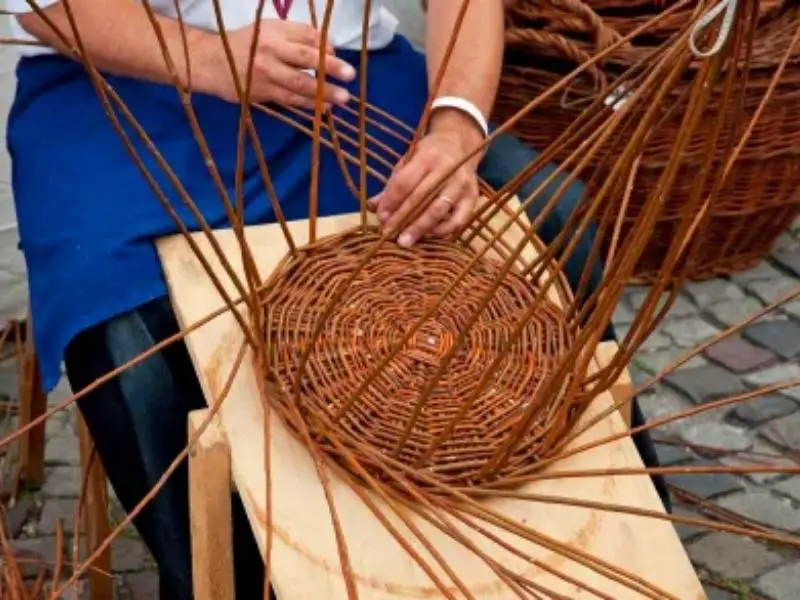
To start basket weaving, you should know about the materials it requires. Luckily, they’re mostly widely available.
You can use any tree bark to make a basket, like a reed, grasses, bamboo, vines, and rattan cores. Willow and oak are equally sturdy and suitable for baskets, but they aren’t as available.
Reed is a flexible material that you easily bend and twist while working, and you’ll find two types available, oval reed and flat reed.
What’s unique about reed is that it can dye easier and faster than most materials. So, if you want to decorate your basket with colors after you finish making it, you won’t face any issues.
Finally, you don’t need any additional tools to weave a basket. Gather your natural materials and stiff fibers and start working on the unique art form.
Frequently Asked Questions
How Long Does It Take To Make a Basket?
The answer depends on your availability and commitment to the craft. But generally, woven baskets with small sizes often take a day or two. However, if you want to make a large basket, it might take more than a week to finish. Also, some basketry methods take more time than others, like wicker.
What Is the Twinning Technique?
The twinning technique is among the four basic techniques of weaving, and it includes crossing two horizontal strands over each other and then crossing them between vertical strands. It isn’t the easiest technique, but you can ace it with more practice.
Can I Use the Plaiting Technique to Make a Placemat?
Yes, you can. You can create the basket’s base and stop there without finishing the rest of it. But make sure to weave your flexible materials tightly to avoid them coming apart. Also, woven objects aren’t easy to clean, so you should ideally seal your placemat.
To Wrap Up
Basket weaving is a pleasant and rewarding skill. And while some techniques are challenging to learn, some are simple, and you can ace them in no time. Luckily, learning this skill doesn’t require any expensive or hard-to-get materials. Instead, you’ll do well with a flexible natural fiber and some courage!
Comments
0 comments

